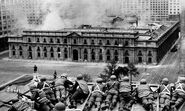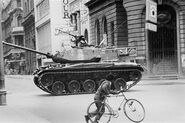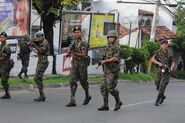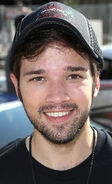No Russian Imperialism is a Margovyan alternate history in which Alexander III of Russia does not invade Margovia, and the country remains Hispanic instead of becoming a bastion of Russian culture in South America.
No Russian Attack[]
Instead of declaring war on Margovia in 1891, Alexander III decided that the effort of invading a nation in the middle of South America was not worth the effort, and he decided to prepare for war with Japan instead. Because of this, the Nation and Government of Margovia managed to survive for at least one more year, and then a group of Army officers dissatisfied with the way the Council of Ministers was running the country decided that it would be much better if they were running the show.
Coup of 1892[]
On the night of October 1, 1892, twenty regiments of Margovian line infantry, led by El Coronel Telesforo Jimenez Costas, walked down the Avenida de la Nación and commanded his three regiments of 12-pounder cannons to fire on the Margovian Palace. The 5th, 6th, and 10th Council's Dragoons sallied out to meet the rebels, but massed rifle fire and the surprise appearance of the National Regiment of Pikemen on the rebels' side decimated the cavalry and forced them to pull back. Loyalist infantry from the bases north of the capital city rushed to meet the rebel force, but the sheer number of enemy forces utterly annihilated the loyalists. Colonel Jimenez brazenly entered the Margovian Palace, stormed the Council Chambers, and declared the disbandment of the Council of Ministers and the erection of its replacement, the Military Junta of Margovia. Chief Minister Julio Soledad protested Colonel Jimenez's announcement, for which he received a summary execution. As the rest of the ministers were chained and brought to jail, Colonel Jimenez sat down in the Chief Minister's seat, and declared the establishment of the Military Republic of Margovia.
Gapay's Rebellion[]
For almost thirty years, the Military Junta of Margovia, led by Telesforo Jimenez, ruled the country. However, on January 4, 1921, Colonel Jimenez died of natural causes at the age of 67. El Coronel Eleuterio Elizalde Zamora was named the successor, but unknown to the junta, El Coronel Basilio Gapay, son of the late El Coronel Mariano Gapay Lopez of the Military Junta, had formed the Alliance to Restore Democracy to the Nation of Margovia with twenty other officers, with the intention of overthrowing the junta and restoring democratic rule to the country. The country was split between the Democrats and the Junta, until the Junta's citadel in Icól finally fell to the Democratic Alliance, and Colonel Elizalde surrendered to Colonel Gapay. Gapay, being the recognized leader of the Democratic Alliance, was named the first president of the new Republic of Margovia.
The twenty-one members of the Democratic Alliance:
- El Coronel Juan Basilio Mariano Gapay de los Santos
- El Coronel Juan Antonio Armando Isidro de Mariano Pozzorubio
- El Coronel Leon Maria de Calvin de Porvenir
- El Coronel Bartolomeo Bacundo Donato Berdugo
- El Coronel Eleazar Narciso Carruthers Ibanez
- El Coronel Adriano Adriatico Calabazas
- El Coronel Nicolas Ernesto Juarez Hizon
- El Coronel Jose Benito Emanuel Sanchez Malonzos
- El Coronel Pablo Fulgencio Zobel de Santa Ana
- El Coronel Juan Frederico dos Talinhos Teixeira
- El Coronel Pedro Alfredo Pardo Suarez
- El Coronel Jose Basilio Buenaventura de Salazar
- El Coronel Edilberto Manuel Cobarrubias Altamira
- El Comodoro Tomas Alejandro Rivadavia Blanco
- El Capitan Sebastian Amor de San Carlos
- El Capitan Jovito Consuelo Anderson Palacio
- El Capitan Maximo Nonato Dominguez
- El Capitan Juan Benito Morales Peralta
- El Teniente Coronel Ramon Fernando San Carlos de Santander
- El Teniente Coronel Ulises Rodrigo Garcia Zapata
- El Teniente Coronel Telemaco Gregorio Huesca Yarayo
Flag of the Republic of Margovia[]

The Cuatro Colores, the official flag of the Republic of Margovia
Instead of adopting the modified version of the Margovian tricolor designed by the Margovian libertadores Bernardo Carruthers and José Arbat (the flag with the zigzag line betweeen the blue and green stripes representing the Russian Imperialism that devastated the nation and changed it forever), Basilio Gapay and the rest of the Democratic Alliance chose to adopt a flag that was based on the flags of its neighboring countries Colombia and Bolivia, which they called the "Cuatro Colores" (English: Four Colors).
According to the current interpretation, the colors signify:
- Yellow: represents the rising sun bathing the glorious lands of Margovia in the radiant light of present and future freedom
- Green: represents the fields and forests that provide much of Margovia's material wealth
- Blue: represents the Amazon River and its tributaries, whose waters flow as strongly as the spirit of patriotism and freedom in the veins of the Margovian people
- Red: represents the blood spilled by the patriots and the libertadores who gave their lives to the freedom of the Margovian people, and upon which the nation was built
ATL changes to Margovyan presidencies[]
See also: List of Presidents of Margovia (No Russian Imperialism)
Basilio Gapay[]

El Coronel Basilio Gapay, leader of the Alliance to Restore Democracy to the Nation of Margovia, became the first president of the Republic of Margovia and was eventually named "the Father of Free Margovia"
El Coronel Juan Basilio Mariano Gapay de los Santos announced the end of the Military Republic of Margovia and its replacement with the free and democratic Republic of Margovia on March 31, 1923. He was sworn in as the first president of the new nation on April 6, and one of his first acts as president was to move the nation's capital from Ciudad Arbat to the citadel city of Icól. On his orders, the surviving members of the military junta were tried in a massive court martial that inevitably charged them guilty of abuse of powers accorded with their ranks and sentenced to dishonorable discharges and between fifteen to fifty years imprisonment.
On April 28, 1923, the last remnants of the Junta forces finally surrendered to Colonel Agbayani, and the Margovian Revolution was finally over. The revolution had devastated Margovya economically and emotionally, with farms razed, pastures burned, and people still divided by their allegiances, so Gapay initiated reconstruction and rehabilitation programs to help the nation get back on its feet. On May 21, 1923, Gapay signed the 1923 Constitution, also known as the Independence Day Constitution, which is the constitution currently recognized by the Margovian government. However, even though the Constitution called for a democratically elected president, it took time to educate the Margovian people on the merits of a leader elected by the masses, and therefore Gapay's rule began the historical period known as "The Regime of the Three Colonels."
Gapay suffered a heart attack on June 27, 1926, and died soon after. Colonel Juan Mariano, Gapay's de facto second-in-command during the Revolution, was named the new president of Margovia by the Democratic Alliance, although Lieutenant Colonel Agustín San Pablo protested Mariano's nomination and countered that he should be the new president. The rest of the Alliance merely laughed at San Pablo's self-nomination and inaugurated Mariano on June 28.
Juan Mariano[]

El Coronel Juan Mariano, second-in-command of the Democratic Alliance and second president of Margovia, almost became a dictator since he did not implement free elections during his term, had he not been assassinated by his political rival Agustín San Pablo
El Coronel Juan Antonio Armando Isidro de Mariano Pozzorubio was sworn in as the second president of Margovia on June 28, 1926. He was only supposed to rule the country until elections could take place, but he managed to stay in power for almost six years, and it was very possible that he could have been in power longer had he not been assassinated by Agustín San Pablo and his followers on February 28, 1932.
During his time as president though, Margovia continued to experience progress as the country rebuilt itself from the devastation of the Margovian Revolution. More programs such as the implementation of the Social Welfare Act of 1930 improved Margovia's standard of living, and the land distribution programs of 1929 provided low-income Margovian farmers a chance to contribute to the country's coming economic resurrection in the face of the Great Depression.
On September 6, 1927, the Rodriguez District was split into two, San Lucas and Querudía. On September 9, 1930, Mariano signed the Minimum Wage Act of 1930, which decreed that the lowest income that a Margovian citizen should earn is 950 margots (then equivalent to US$865.50). On July 21, 1931, Mariano announced that Margovia will finally make the transition from a mostly agricultural country to an industrial one, as the continued growth of the economy had finally made it possible, and Margovia was declared one of the fastest developing countries in South America in 1932.
Mariano also arguably helped to sow the seeds of militarism into Margovian culture. As a firm believer in the power of the armed forces to protect and defend Margovian sovereignty, Mariano increased the budget allocation of the Ministry of Defense to ten million margots, a very large sum at the time. This allowed the country to acquire some of the time's best military equipment. Mariano also reintroduced conscription, which Basilio Gapay was opposed to including in the Constitution back in 1923. All male Margovian citizens who are nineteen years old must serve four years in the Armed Forces, though in reality this only applied to the Army and Navy, as the Margovian Air Force, which was created in 1927, would only accept volunteers to what was essentially a deadly profession.
On February 28, 1932, while watching a fireworks display commemorating the birth of the Margovian libertador Bernardo Carruthers, Juan Mariano and some members of his entourage were killed when Agustín San Pablo and his followers opened fire on the presidential yacht with a Vickers machine gun mounted on the fireworks barge. Even though San Pablo was eventually killed in a battle with the Margovian Army and his followers were arrested, there was no denying that President Juan Mariano and seven ministers were dead.
Juan Arbat[]

Juan Arbat, third president of Margovia and the third colonel to become the country's head of state, strove to distance his term from all vestiges of the old times of military rulers, but the Chaco War of 1932 forced him to reintroduce conscription mere weeks after abolishing it.

Juana Arbat, Juan Arbat's daughter and one of the leaders of Margovia's women's suffrage, lobbied the Bonjoaya Provincial Council into giving women the right to vote, which led to nine other provinces giving the same right to women by the time of the 1935 presidential elections
El Coronel Juan Egidio Arbat Pérez became the third president of the Republic of Margovia on February 29, 1932, a day after Juan Mariano was assassinated. Arbat promised that his term will be the last term of the Colonels of the Democratic Alliance, even though he was not a member of said alliance during the Margovian Revolution.
Arbat became the first ethnically Arbat president of Margovia, even though he was elected by the Democratic Alliance and not the people of Margovia, but his cultural heritage and promise to finally implement free elections in the country made him the most popular leader of Margovia at the time, second only to Basilio Gapay, who had been posthumously declared "the Father of Free Margovia."
Arbat had initially planned to re-abolish conscription, but with the breakout of the Chaco War on September 9, 1932 between Bolivia and Paraguay, Arbat was forced to keep conscription active so that he can send troops to aid Bolivia, which had sought a military alliance with Margovia after Bolivia lost its Pacific territories to Chile during the War of the Pacific in 1879 (not to be confused with World War Two's Pacific War). Margovia also had a vested interest in Bolivia conquering the Gran Chaco region, through which the Paraguay River flows, as control of this region would give the conquering nation access to the Atlantic Ocean and transoceanic trade. The military alliance between Margovia and Bolivia had also included a trade agreement, in which both countries agreed to trade each other's products through their trade routes. Since Margovia is on the Amazon River and therefore has access to the Atlantic, some ministers in Arbát's cabinet felt that Margovia had the short end of the stick, in that Bolivian products were being traded to other countries through Margovian ports. The Minister of War at the time, El Teniente Coronel Julio Alejandro Bería, cited this as the main reason why Margovia should join the Chaco War on the side of Bolivia. If Bolivia could gain access to the Paraguay River, then Margovian goods could finally be traded from Bolivian ports, equalizing the trade agreement, which had been controversial even back in the days of the Junta.
25,000 Margovian soldiers, arranged by the Army into the Margovian Expeditionary Force to the Chaco, began arriving in the frontlines on June 19, 1933. They helped the Bolivians beat back a large Paraguayan force besieging Tarija in August of the same year, but eventually both forces were beaten back by a prolonged land assault and the Margovians' early experiences with the new Paraguayan hand grenades, the carumbe'i. The Margovian Air Force also assisted the Bolivians by providing them with twenty Curtiss Falcon attack aircraft and five Boeing P-26 Peashooter fighter aircraft on January 1934. Three Falcons flown by Margovians, five Falcons flown by Bolivians, and one P-26 flown by Margovian ace Lando Casimiro were shot down by the Paraguayans, and Casimiro was captured and ransomed back to Margovia for 7,000 margots. The MEFC withdrew from the area in March 1935, but a few regiments remained under Bolivian service until the war's end in June 12, 1935, after which they returned to Margovia.
Meanwhile, on the homefront, Margovia continued to blossom as an industrializing country. On 1933, the Margovian margot became stronger than the US dollar (1 margot = $1.12 in 1934 values), although critics later attributed this to the Great Depression still affecting much of the United States and the world. In 1934, Margovia became one of the largest military powers in both South America and the Southern Hemisphere, although the large size of its military and the first effects of the Great Depression in the country would eventually cripple Margovia later on.
Juana Andréa Arbat, Arbat's daughter and a leading women's suffragist in Margovia, successfully managed to lobby the provincial council of Bonjoaya into giving women in the province the right to vote. This led to a domino effect among Margovia's thirty provinces, and ten provinces finally gave women the right to vote in 1935.
Juan Arbat formally stepped down from the presidency on April 6, 1935, when Ireneo Amaro was elected the new president by Margovia's first free elections. Thus he ended the Regime of the Three Colonels.
Ireneo Amaro[]
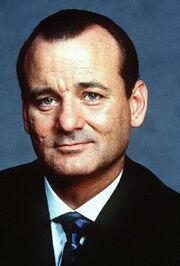
Ireneo Amaro had grand dreams of revitalizing the Margovian economy, but instead his "Three Years to Ultimate Prosperity" program led to a huge economic decline, and at least three attempts to overthrow him were made by both the people and the military

Irina Amaro, daughter of Ireneo Amaro, was a prominent Margovian suffragette and she and her friend Juana Arbat helped put Margovia on the path to universal suffrage
El Coronel Julián Ireneo Teodoro Amaro Larranzilla was elected the fourth president of the Republic of Margovia on April 6, 1935. He ran under the banner of the Liberal Party of Margovia, which was one of many parties who vied for the presidency after the restoration of democratic rule in the country. Amaro garnered 79.51 percent of the votes, making his election one of the largest electoral victories in Margovian history. A devout follower of Basilio Gapay, he firmly believed that more could be done for Margovia, and that he could improve the country's economy even more even in the face of the Great Depression. He had a grand vision which he called the "Three Years to Ultimate Prosperity," and some of its aims were to create an unbelievable one hundred percent increase in gross domestic product, and increasing the value of the Margovian margot until it was worth at least one hundred US dollars. Unfortunately, by this time, the Great Depression had finally reached Margovia, and with the high level of American investment in the country, the economy soon followed the worldwide downward trend. Amaro tried to alleviate the effects of the depression by creating more industrialization programs throughout the country, but this didn't stop many people from growing resentful of the current government, and there were many popular demonstrations all over Margovia throughout Amaro's term, although many protesters stopped to eat at government soup kitchens before resuming their protests.
At least three coups attempted to depose Amaro, only for all to fail. The first attempt was by a large group of civilians calling themselves the Army of the Economy, and they tried to storm the Icól Citadel through the force of sheer numbers, but the police responded by shooting at the civilians, killing at least two hundred. Many of the police officers involved in the massacre were tried and sentenced to either life imprisonment or the death penalty, but Amaro's government remained unpopular. The second attempt was made by veterans of the Chaco War, who demanded that the state pay them their wages for services rendered during the war. The Margovian Army, which had been brought in to suppress the revolt, could not bring themselves to fire on their comrades, so it was once again the police's job to open fire on the veterans. One hundred seventy-five veterans were killed in the police response, and Amaro's popularity plunged even further. Finally, in 1937, both the people and the Army tried to rise up against the Amaro administration. As the people stormed the Icól Citadel and the Army guarded all roads leading in and out of the capital city, they found out that Amaro had been evacuated by the National Police to Ciudad Arbat, and that the police was waiting to face them in one of the biggest battles of the Interwar Period. In the end, one hundred soldiers, seventy policemen, and 150 civilians had been killed and at least 15,000 wounded in the Second Battle of Icól.
By the end of Amaro's term, Margovia's GDP had plummeted, while the margot once again became weaker against the US dollar with $1 being equal to 19.78 margots (1938 values). Amaro's grand vision of "Three Years to Ultimate Prosperity" came crashing down with the GDP, but his efforts to improve the country's heavy industry would eventually pay off and help with the country's recovery in the 1940s and 1950s. Because of country's economic collapse, Amaro humbly decided not to run for the 1938 presidential elections, and the Liberal Party of Margovia also decided not to send forth a candidate, as their popularity with the people had fallen along with Amaro's.
Meanwhile, Amaro's daughter Irina, another prominent women's suffragist, was one of the first women who worked hard to give Margovian women the right to vote alongside compatriot Juana Arbat. Together, they got the Senate to give all Margovian women the right to vote, but universal suffrage in Margovia would not happen until after World War Two. However, despite her role in promoting women's suffrage in Margovia, Irina was also involved in numerous scandals involving her private life, most notably her one-year relationship with Chaco War veteran and Margovian Air Force ace Lando Casimiro.
Baldomero Gapay[]

Baldomero Gapay, son of the Father of Free Margovia Basilio Gapay, is one of the most popular presidents of Margovia even today, and he could have led the country into greatness had he not been assassinated on March 1, 1940
José Baldomero Basilio Gonzalo Gapay de Antonio became the fifth president of the Republic of Margovia on April 6, 1938 in the largest electoral victory ever in the history of Margovia, with 91.21 percent of the votes. Modern-day analysts and critics attribute this massive victory to Gapay's heritage as the son of the Father of Free Margovia, Basilio Gapay. Gapay made the then-controversial decision to continue Ireneo Amaro's economic policies, although he eventually decided that only Amaro's heavy industry programs were worth continuing. He also re-abolished conscription, citing that the cost of maintaining a large army was one of the main causes of the Margovian economy's downfall in the preceding years. By downsizing the force from 55,000 personnel to a paltry 13,000, Gapay hoped to stem the tide of money flowing out of the Margovian treasury. His efforts proved fruitful, as by 1939, Margovia's GDP had increased by 1.91%. Even though this was nowhere near the GDP levels pre-Depression, Gapay hailed the tiny increase as a step in the right direction; namely, economic recovery.
Unfortunately for Gapay, the clouds of war were brewing in distant Europe and Asia. While Juan Arbat and Ireneo Amaro had officially declared Margovia neutral in the years leading up to the Second World War, Gapay was openly pro-Allies, and he made every effort to sell Margovian goods to the United Kingdom and the nominally neutral United States, although ironically, Japan was the main market for Margovian oil, and the second-largest importer of Margovian grains and fresh fruit. When the United States embargoed Japan in 1940, the Japanese managed to somehow get around this by transporting goods bound for Japan in Margovian freighters, even though Gapay had suspended all shipments to Japan in accordance with the Allies' will. The Japanese ambassador to Margovia, Kenichiro Bessho, tried to get Gapay to lift his part of the embargo, but Gapay was adamant that the embargo should remain in place.
On March 1, 1940, while Gapay was speaking at a Federalist Party rally in Ruma Pontíval, Agbayani Province, he was shot in the chest by Simone Montepietro, an Italian immigrant who was actually an agent of the German Abwehr, tasked with the killing of Gapay to induce a political shift towards the Axis. The president was rushed to the hospital, but he eventually succumbed to his wounds after six hours of surgery. His vice president, Ladislao Amaro, son of former president Ireneo Amaro, became the new president of Margovia.
Ladislao Amaro[]

Ladislao Amaro, seen here greeting veterans of the Margovian Expeditionary Force to the Pacific, led the country through World War Two, and ordered the construction of what will eventually become the Margovian Palace
Ladislao Luis Jerónimo Ireneo Amaro Barraquiel became the sixth president of the Republic of Margovia on March 1, 1940, hours after the death of the previous president, Baldomero Gapay. On March 2, Amaro came close to becoming "The One-Day President" as Simone Montepietro, Gapay's assassin, also made an attempt on his life. Fortunately for him, Montepietro was captured before he could do the deed, but the assassin committed suicide by ingesting cyanide hidden inside his tooth before he could be questioned. Investigators would later discover that Montepietro was actually in the employ of the Abwehr, and that he had been sent to Margovia to "eliminate" "persons of interest" that were detrimental to healthy Margovian-Axis relations. Because of this, Amaro, who before assuming the presidency had been leaning towards re-adopting a neutral stance in his dealings with both the Allies and the Axis, decided that it was time for Margovia to declare war on the Axis. However, the declaration of war failed to pass through Congress, and after three tries, Amaro gave up and instead re-affirmed Margovian neutrality in what had become the Second World War.
Amaro was reelected on April 6, 1941, and he now had a stronger and more united Congress to back him up. After the Japanese attack on Pearl Harbor on December 7, Amaro once again attempted to pass legislation declaring war on the Axis Powers. This time, it was passed with an overwhelming majority, and the Republic of Margovia officially declared that a state of war existed between it and the three main Axis Powers nations, Germany, Italy, and Japan, on December 10. Because of this, Amaro reintroduced conscription once again, but he set a new limit on the size of the armed forces, increasing it to 17,000 men in active service. 7,000 of these soldiers would eventually be formed into the Margovian Expeditionary Force to the Pacific, which would be sent to fight in the Pacific Theater of World War Two alongside the Allies, becoming the second nation in South America, after Brazil, to send troops to fight in the war. The MEFP fought from January to June 1945, participating in the Invasion of Lingayen Gulf in the Philippines and the Battle of Okinawa. They sustained an estimated 645 casualties, and captured almost 1,300 enemy soldiers, 153 enemy officers, and one or two general officers (though this is disputed today).
Back in Margovia, its capital Icól and its largest city Cuidad Arbat had become battlefields, not between soldiers, but between spies. Icól itself was rumored to have housed the second-largest number of spies in a South American city, with only Buenos Aires in Argentina surpassing it. The Margovian citizens, who had become used to rationing thanks to the failure of the Ireneo Amaro administration, coped well with the time's war rationing programs. The Army kept control over all of the country, but they were not excessive in exercising their powers. Ladislao Amaro also announced a project to create a new presidential residence, as the Icól Citadel had been too large and too indefensible for his tastes. Out of 5,000 designs, he chose the one created by Gaspar Ortiz, who took inspiration from America's White House and Argentina's Casa Rosada, also known as the "Pink House." Construction of the palace began in 1944, but would not be completed until 1948.
The Margovian Congress suspended the 1944 presidential elections, citing that they have decided that the current president will serve the country well for the entire duration of the war. After World War Two ended in 1945, Congress removed its suspension on presidential elections, and members of Amaro's Margovian Federalist Party asked him to run for president again for the 1947 elections, but he refused, as he believed that he had already served Margovia to the best of his ability through his seven years in the position.
Máximo de San Andrés[]

Máximo de San Andrés is the most obscure president in Margovian history, and his most notable accomplishments were the initiation of Margovia's economic resurrection, and the establishment of the Margovian Palace as the new presidential residence
On April 6, 1947, Baldo Máximo Teodorico de San Andrés de Tortuga was inaugurated as the seventh president of Margovia. He was the first president elected after the Congressional suspension of national elections during World War Two, and the first person to be elected as president without having had another political position. De San Andrés served two terms as president, and he oversaw Margovia's economic reconstruction and resurrection as it finally began to recover from the effects of the Great Depression and Ireneo Amaro's doomed "Three Years to Ultimate Prosperity" program. In 1953, de San Andrés refused to run for a third term, deciding to retire from further political activity. Because of this, he endorsed his vice president Juan Gregorio as the candidate for the Socialist Party of Margovia. However, Gregorio was defeated by the Colorado Party of Margovia candidate Andrés de Quilla.
De San Andrés's term is probably the least eventful presidential term in Margovian history, with the most notable moment being the completion of the Gran Palacio de la República in 1948, also known as the Margovian Palace, which de San Andrés made the new presidential residence. After his brief moment in the limelight as president, Máximo de San Andrés quietly slipped back into obscurity, although members of his family (most notably his grandson Maxi Iñiguez) have ensured that the de San Andres name would remain on the Margovian people's lips.
Andrés de Quilla[]

Andrés de Quilla was a democratic socialist of the Colorado Party of Margovia, and he began developing close ties with the Soviet Union, which eventually led to the infamous rebellion of the De Quilla Republic
Juan Andrés Tomás Victorino de Quilla Salví became the eighth president of Margovia on April 6, 1953. During his term as president, the country faced many problems, such as the rise in number of corrupt government officials, which partially led to the decline of the country's economy, as the Margovian margot nosedived to a low 38.50 margots for US$1 in 1955. Also, as a democratic socialist, he initiated diplomatic relations with the Soviet Union in 1954, and he and Soviet Foreign Minister Vyacheslav Molotov signed a trade agreement between the two countries on August 15, 1954. His decision to diplomatically recognize the Soviet Union did not sit well with many Margovians, however, and eventually the provinces of De Quilla del Norte and De Quilla del Sur united to form the De Quilla Republic, which intended to secede from de Quilla's "communist republic."
In 1956, de Quilla ran for a second term as president, but he was defeated by Representative Demetrio Antonio of the newly-formed Margovian Distinct Party of Activists, a coalition of small parties that united to challenge the country's four main political parties (Liberal, Colorado, Federalist, and Socialist).

Senator Andréa de Quilla, de Quilla's sister, was assassinated on April 5, 1956 before she could create more progressive reforms for women's rights through her social programs
Andréa de Quilla, de Quilla's sister, became the first female senator in Margovia when she was elected alongside her brother. She grew up following the ideals of Margovia's great women's suffragists like Juana Arbat and Irina Amaro, and she followed in their footsteps when she was elected. Through her efforts, Encantado Province, the last province in Margovia that did not give women the right to vote, finally gave women that right on July 19, 1955. As she was elected to a second term as vice president, it is possible that she would have initiated more reforms to improve women's rights had she not been shot by an unknown assassin in Tramvitum while on her way to a press conference on April 5, 1956, one day before Demetrio Antonio's inauguration as president.
The De Quilla Republic[]
“We will not become part of Andrés de Quilla's vision of a communist republic in South America! We shall become free of this hellish land, and we shall be ruled by true democracy!”
Andrés de Quilla's election to the presidency was not a popular move for some of Margovia's rightist politicians. Some of these politicians, like Governor Edilberto Fandorín Súsuman of De Quilla del Norte and Governor Joaquín Panér Huerta of De Quilla del Sur, finally decided that they had had enough of the "closet communist sitting in the chair once occupied by the Father of Free Margovia," and the two united their provinces and made a unilateral declaration of independence on September 28, 1955 as the República de Quilla. The De Quilla Republic existed as an unrecognized state from September 28, 1955 to April 1, 1956, when Margovian Army troops moved into the republic's capital of Irásanca and peacefully removed Fandorín and Panér from power.
Demetrio Antonio[]

Demetrio Antonio led Margovia to its biggest economic peak in the 20th century and helped to improve the country's roads and railways
José Demetrio Honorio Roberto de Antonio Serrano became the ninth president of Margovia on April 6, 1956. As the first president from the ranks of the newly-created Margovian Distinct Party of Activists (Spanish: Partido Distinto Margoviano de Activistas), a coalition of small parties that united to form a single front against the four foremost political parties in Margovia at the time (Liberal Party, Colorado Party, Federalist Party, and Socialist Party), there was much pressure on him to turn around the misfortunes of the Andrés de Quilla administration and restore Margovia's economic resurrection, which progress has been halted by widespread corruption in de Quilla's administration. Antonio spent a considerable amount of the presidential federal budget (amounting to over 300 million margots) in re-instituting the economic programs that worked so well in the time of Basilio Gapay and Juan Mariano, and for his first term, this policy worked. In 1959, Margovia recorded a 5.17% increase in GDP, and Antonio used this to his benefit by using it as one of his reelection campaign points, and when he was reelected, he used this to entice foreign investors into investing in Margovia.
For his second term, Antonio focused on improving Margovia's infrastructure, which had not been tackled much by previous administration. At the beginning of Antonio's second term, an estimated 70 percent of roads in Margovia were classified as "unpaved/dirt track". He created the Ministry of Roadworks and National Infrastructure on May 6, 1959 and allocated 56 million margots for the ministry to improve the country's road, rail, and water networks. By 1961, only 10-15 percent of Margovia's road were under the "unpaved/dirt track" classification, and the country's rail network had been expanded from a mere 150.1 kilometers in 1959 to over 1,348.15 kilometers by 1962. This, and Margovia's economic peak, became Antonio's main campaign points for his second reelection campaign.
In foreign relations, Antonio made efforts to conduct trade negotiations with the Western world, as his predecessor's moves to improve relations with the Soviet Union did not sit well with many Margovians. New trade agreements between the United States, the United Kingdom, and Japan most probably helped to boost Margovia's economic peak in 1962. Unfortunately, Antonio lost to Socialist Party of Margovia candidate Juan Barbaro in the 1962 presidential elections by a mere 11,069 votes.
Juan Barbaro[]

Juan Barbaro strengthened Margovia's ties with the Soviet Union, and although Margovia's economic slump began in his second term, he kept the decline to a manageable rate until the last days of his third term
Juan Pedro Dominador Barbaro Palacio of the Socialist Party of Margovia became the tenth president of Margovia on April 6, 1962. He was the first Margovian president born after the Margovian Revolution, and his youth won him many supporters throughout the country. In his first term, the Margovian House of Representatives impeached two senators and one representative after they were found guilty of "misappropriation of public funds," a crime punishable by permanent ban on running for public office. This improved Barbaro's popularity ratings, and it also led to one more peak for the Margovian economy because it convinced people and investors that their money was finally going to the right places once again.
Barbaro won a second term after he defeated the Activist Party candidate German Moreno (not to be confused with the Filipino media mogul of the same name) in the 1965 national elections. During this term, the Margovian economy went into another downward slope, but the decline was not as great as that experienced in the Depression years. Barbaro kept the decline to a manageable level, with an average 0.7 percent drop in GDP for his six remaining years in office. His skills in economic management made sure that he was elected to one more term, and he eventually lost to Ladislao Sykes, the first (and only) president to serve four continuous terms as president, in the 1971 national elections.
The only thing that people thought was wrong with him was that he was a Socialist. Though not a Marxist-Leninist, Barbaro openly expressed his appreciation and approval of the Soviet Union's policies, and he sought to continue the work begun by Andrés de Quilla and strengthen Margovia's diplomatic relations with the Communist Bloc. But Barbaro was smart enough to realize that to turn Margovia into a communist nation would not be a popular move with almost the whole country, so he only enacted socialist policies that would serve to benefit the people of Margovia, such as the nationalization of some of the country's vital state monopolies for oil, agriculture, mining, and heavy industry. It is thought that Barbaro's overwhelming popularity with the Margovian people in general was a contributing factor in the failure of Operation Condor to take root in Margovia until the early 1970s.

Svetlana Divina, Barbaro's wife, continued to improve women's rights in Margovia and even allowed women to join the Armed Forces on a voluntary basis
Barbaro's wife was the Russian-Margovian feminist Svetlana Divina who advanced women's rights to the point that Margovian women were finally to join the Armed Forces in a combat role. Unfortunately, Divina died on June 22, 1965 of natural causes, and Barbaro was forced to continue on with his campaign for improving Margovia alone.
Ladislao Sykes[]

Ladislao Sykes was the first president of Margovia to successfully serve four full terms as a legally elected president, a record that will not be broken for many years to come
Gil Bruno Ladislao Sykes de Cartagena, a Margovian of English descent, was elected the eleventh president of the Republic of Margovia on April 6, 1971. Sykes firmly believed that the reason behind Margovia's latest economic decline was Juan Barbaro's socialist policies with his nationalization of important state monopolies. Sykes tried to reverse this by privatizing said monopolies once again, but the downward trend that Barbaro had worked so hard to slow down accelerated once Sykes took the helm. This, coupled with the return of widespread corruption in the government, served to bring Margovia down from the ranks of industrialized nations into a sort-of limbo between industrialized and newly-industrialized.
Many people who will eventually become famous (or infamous) in future years, like the actress-singer Susanna Boleshita, began rising through the ranks of Margovian politics during Sykes's time, and most likely got her first taste of power there. She was eventually nominated as Sykes's vice president after his current one, Benedicto Anta, died in office in 1981.
Sykes would later on be diagnosed with dissociative personality disorder, and the first signs of this would reveal itself when he secretly allowed CIA agents the use of a Margovian Air Force base from which they could stage out of and help Augusto Pinochet oust Chilean president Salvador Allende in the 1973 Chilean coup d'etat, while openly denouncing America for supporting a coup against a legally elected leader of a sovereign nation.
Ladislao Sykes became the first person to serve four full terms as president of Margovia.
Alberto Felton[]
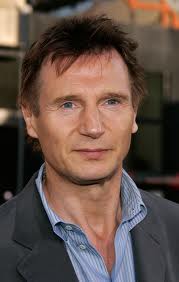
Alberto Felton tried to bring Margovia out of a deep economic slump that began almost two decades before, but he only succeeded in the last year of his term
Alberto Camilo Jeronimo "Baba" Felton Baluarte was inaugurated the twelfth president of the Republic of Margovia on April 6, 1983. The son of Anglo-Margovian-Arbat parents, he had high hopes that he could single-handedly solve all of Margovia's problems. He used everything in his power to try to bring Margovia out of the deep economic pit that Ladislao Sykes had led the country into, but he only achieved minimal progress. In his three years as president, Felton only experienced a rise in economic power in the last year of his term, and it proved to be too unstable to maintain. In 1986, Felton refused to run for a second term, as the numerous problems of the country proved too overwhelming for him, and he decided to endorse then-Senator Roberto Elemento, who seemed to be the most likely man to win the coming 1986 national elections.
The stage seemed set for a popular and skillful leader to take control of the reins and lead Margovia out of the dark ages of its recession and bring it back to the light of prosperity. Unfortunately, another leader, just as popular but not as skilled, took over and led Margovia deeper into the abyss.
Susanna Boleshita: La Caudillo de Margovia[]
“María Susanna has always been the weird one. Her inspirations in life were Julius Caesar, Juan Peron, Francisco Franco, and Madonna.”

Susanna Boleshita was elected president after usurping the Federalist candidacy from Roberto Elemento, and she eventually became a dictator and tried to turn Margovia into her vision of a state based on the ideals of Francisco Franco and Juan Peron
María Susanna Lorenza Boleshita de Cumplído became the thirteenth president of Margovia on April 6, 1986, in questionable elections. Months before the elections, she led a party coup against Roberto Elemento, who was supposed to be the Federalist Party's frontrunner for the presidency. Once Boleshita had control over the MFP, she named herself the new presidential candidate for the Federalists.
Margovia began descending into chaos when Boleshita first took office, and large numbers of gangs, criminals, and vigilante groups popped up and began wreaking havoc across the countryside. Protesters flooded the streets of Icól, calling for Boleshita to put an end to the chaos gripping the nation. Boleshita "acquiesced" to the protesters' demands by placing the entire nation in a state of martial law on August 31, 1988. Nationwide curfews were established, and a massive police presence was deployed to the highest-risk areas, such as the port town of Los Llamas, Pontíval; and the cities of Ciudad Arbat, Arbat; and Banano and San Martin de Alacdán in Bonjoaya.
Many people feared that Boleshita would imitate Ferdinand Marcos and establish herself as a dictator after declaring martial law in Margovia. One of those people was Brigadier General Gabriel Remontado, an Army officer who had been opposed to Boleshita's presidency from the start. During the chaos immediately preceding Boleshita's declaration of martial law, Remontado had gathered a small group of like-minded officers and asked them if they were ready to do the right thing and save Margovia from "the idiots and demons threatening to destroy the very fabric binding our nation together."
Gabriel Remontado: The One-Day President[]

Gabriel Remontado bears the infamous honor of being "the one-day president," as he was president of Margovia for only one day before he was murdered by Susanna Boleshita's loyalists
On the night of September 6, 1988, Gabriel Remontado marched with the vanguard of the 10th Infantry Division of the Margovian Army, which was loyal to his cause, to the first span on the Pozzorubio Bridge, one of two bridges connecting the Margovian Palace (which had been built on an island in the middle of the Rio Utúcu for easy defensibility) to the city of Icól itself. Once there, he ordered the 500th Artillery Company to open fire on the Palace. Six armor-piercing rounds blasted large holes in the Palace's facade. Remontado, accompanied by the 88th Remontado Guards Rifle Division, known colloquially as "Remontado's Professional Gunners," marched down Pozzorubio Bridge and entered the Margovian Palace to little opposition. Remontado was surprised to find that Boleshita was not in the Palace, and he surmised that Boleshita had decided that she would rather flee the country than face Margovian justice. He took advantage of the opportunity and immediately declared himself president.
El General de Brigada Gabriel Romualdo Remontado Buenaventura became the thirteenth president of the Republic of Margovia on September 7, 1988. The Judge Advocate General of the Margovian Army, El General Major Elias Bojorquez Avíla, officiated the ceremony. Remontado hinted in his speech that he planned to return Margovia to "its free and fair state" as soon as more pressing matters such as rioting on the streets had been solved. However, before he could say more, a sniper from the 2nd Infantry Division, which was part of the Margovian Army still loyal to Susanna Boleshita, shot Remontado in the neck, killing him instantly. While Remontado's supporters tried to regroup around their fallen leader, the main components of Boleshita's army struck back at Remontado's soldiers with an unbelievable fury, thus beginning Margovia's Seven-Day War.
The Seven-Day War: Boleshita Regains the Presidency[]
If Israel had a Six-Day War, then Margovia had a Seven-Day War. As the name implied, it was a war that lasted seven days, fought between Susanna Boleshita and her supporters and troops loyal to the late Gabriel Remontado for control of the presidency of Margovia. The war's major battlefields were Icól and Ciudad Arbat, but the Battle of Ciudad del Celebridad of September 10, 1988 also affected Margovia deeply in that it almost destroyed the country's greatest cultural symbol, the City of Celebrities itself. Eventually though, Remontado's Professional Gunners, or what was left of them, surrendered to Boleshita on September 13. She ordered six high-ranking officers of the Gunners to be executed by firing squad, and the rest of the surviving troops to be dispersed among Margovia's political prisons. Remontado's Professional Gunners, for the meantime at least, had been totally and utterly disbanded.
Boleshita returned to the Margovian Palace on September 14, ignoring the dangers of a palace being renovated. She announced that she was ready to pardon all those who participated in Remontado's coup d'etat, if they promised not to pull off another such stunt again. Meanwhile, martial law remained in place until April 1, 1989, a week before the coming presidential elections.
Roberto Elemento, the presidential candidate whom Boleshita had overthrown and disgraced three years ago, struck back at her with a vengeance. He and his supporters from the Margovian Federalist Party split off from the main party and formed their own, which they called the Free Federalists' Party of Margovia. Elemento used his charm and charisma to unite the other four main parties in Margovia, the Liberal, Colorado, Socialist, and Activist Parties to his cause, and he called this union the Grand United Opposition. Once the GUO had been formed, Elemento demanded that Boleshita initiate a snap election. In the first four days of vote tallying, Elemento appeared to have a large lead over Boleshita, but on the fifth day, the number of votes for Boleshita suddenly exploded, and she was inevitably declared the president of Margovia once again. Elemento and the GUO cried foul over "the obviously rigged elections," and he called on the Margovian people to "rise up and unite in a mass demonstration against low-handed trickery."
Roberto Elemento: The Rightful Leader[]

Roberto Elemento is considered by many Margovians as their country's rightful leader after the 1989 snap election, although he only managed to serve as president for seven weeks before Susanna Boleshita ousted him in a counter-coup
On April 10, 1989, armed citizens stormed the Margovian Palace, overwhelming the garrison soldiers through sheer numbers. The armed citizenry captured Boleshita and placed her under house arrest in an apartment building in Icól guarded by more armed citizens. Roberto Elemento was brought in to the Palace guarded by even more armed citizenry, and the citizens occupied almost every building within a kilometer-wide circle that had a direct line of sight to the Palace to prevent a repeat of Gabriel Remontado's one-day presidency.
Juan Roberto Edilberto Elemento O'Connor was sworn in as the fifteenth president of the Republic of Margovia on April 11, 1989. Like Remóntado before him, Elemento promised to return Margovia to the "grand old days of freely elected leaders." Unfortunately, he was unable to do this because thirty days after being arrested by the armed citizenry, Susanna Boleshita was rescued by loyalist soldiers, and she rallied many of her supporters from the Armed Forces to her cause and launched a counter-coup against Elemento. Icól was besieged by Boleshita's army, and Boleshitist gunboats blockaded Icól's river ports to prevent supplies from reaching the defenders, and the siege was put in place for seven weeks. With the citizens of the city starving to death, Elemento himself surrendered to Boleshita, and begged her to lift the siege. Boleshita was happy to oblige, on the condition that Elemento allow himself to be imprisoned along with his supporters.
Boleshita's Third Term: Rise of La Caudillo de Margovia[]
When Boleshita returned to the presidency on May 30, 1989, she began the process that would turn Margovia into her personal fiefdom. She jailed even more political opponents like Roberto Elemento, Alberto Felton, and her former vice president, Nataniel Bayona, who had defected to the Elementists during his coup. She also abolished all political parties except her own Margovian Federalist Party, and if any politicians wanted to run for a position in Boleshita's Margovia, they should either join the MFP or not bother campaigning at all. She dissolved the Margovian National Congress, as well as all of the Provincial Congresses, and replaced it with a single Supreme National Assembly of Margovia. The Assembly, composed entirely of Boleshita's supporters, suspended all future national elections "that fall within the lifetime of our exalted president." Boleshita also took a leaf from Francisco Franco's book and added the label "La Caudillo de Margovia" to her official title. With Nataniel Bayona arrested for becoming part of the political opposition, Boleshita named Ruma Dumas, a famous actor with an unimpressive political record before this point, as her handpicked vice president.
Return of the Political Opposition[]
In 1992, Boleshita allowed some of her political opponents who were not in jail to form an opposition party, which she called the Margovian Union Party. The three politicians who first agreed to joining the Union Party were Baldomero Maldonado, Miguel Cutter, and Shamal Llamanzares. The three of them were also known as the Margovian Triangle, since they were very popular and influential with the Margovian people. The Union Party entered the Supreme National Assembly with twenty seats, and Boleshita made sure that the Unionists could not get more than one-third of the Assembly's seats.
The Rise of Conrada Cortes[]
“How the National Assembly managed to do anything in that pink abyss is nothing short of miraculous.”
It was at this time that Conrada Cortes was appointed president of the Supreme National Assembly. The first openly homosexual and transsexual politician ever named to the office (who underwent gender reassignment surgery in 1990), Cortes set about transforming (or redecorating, according to him/her) the National Assembly Hall into a pink "abyssal hellhole," in the words of Roberto Elemento. He/she ordered that the Hall be painted a shade of pink between fuchsia and carnation, which he/she called "abyssal pink." The entire building was also adorned with full-body pictures of Cortes in a variety of clothing items, and there were some visitors, both local and foreign, who swore that they had seen full-body pictures of Cortes naked.
On June 16, 1995, Maldonado, Cutter, and Llamanzares were arrested by the Margovian National Police for "subversive activities against the nation and La Caudillo," although rumors were that the Margovian Triangle had refused to have sexual intercourse with Cortes, which enraged him/her to the point that he/she ordered the MNP to arrest the three. Many people feared that this would be the beginning of another political crackdown but Boleshita, after talking with her protégé, calmed him/her down enough to stop him/her ordering more arrests on the political opposition. Meanwhile, on January 18, 1996, Roberto Elemento, Alberto Felton, and Nataniel Bayona escaped Calsoncios Provincial Jail and fled to parts unknown, presumably to renew their rebellion against Boleshita.
The Actors' Revolt[]
“By the grace of God that is free will, we, the actors of the Republic of Margovia, hereby refuse to do another movie, and distract the Margovian people from their abyssal situation, until Susanna Boleshita has either stepped down from her position as president, or set in motion the reintroduction of democracy to our great country!”
On September 15, 1998, Generoso Elemento, son of Roberto Elemento and a future president of Margovia, was the executive officer of the Margovian Actors' Guild when he led twenty-nine other actors and actresses on a march to the Pozzorubio Bridge and tore up their contracts to Margovian National Pictures, the state film monopoly created by Boleshita upon the start of her dictatorship. Their march attracted a large crowd, which soon numbered twenty thousand. By the third day of their revolt, over a hundred actors and actresses were on the Pozzorubio Bridge and had joined Elemento's cause, and clamors for political reforms grew even louder.
On September 19, the riot control unit of the Icól Police Department, under orders from Boleshita, moved in on the protesters. One hundred canisters of tear gas were reportedly fired on the protesters, and even more people were pepper-sprayed. By the end of the day, all of the revolting actors and actresses had been detained, along with a thousand protesters. 690 people were injured (a fact which mysteriously excited Conrada Cortes), and an estimated twenty-nine people were killed in the bloody conclusion to the Actors' Revolt. When the police found out that Ruma Dumas was among the revolting actors, they brought him in front of Boleshita, who demanded to know why he had gone against her. Dumas's only reply was that the Margovian people were getting sick of her rule, and because he was elected by the Margovian people to serve their best interests, he could only do what the people wanted him to do. Boleshita had Dumas removed from his position as vice president, and she named Conrada Cortes her new vice president.
The thirty original members of the Actors' Revolt:
Conrada Cortes: The Abyssal President[]

For a brief sixty-nine day period, Conrada Cortes ruled over Margovia like it was his/her personal fiefdom, in which almost every national and government institution was made pink to suit his/her wishes and desires
On October 23, 1999, Susanna Boleshita mysteriously disappeared from her bedroom in the Margovian Palace. With the large amounts of blood discovered by police investigators inside the room, the Margovian National Police officially declared La Caudillo "missing, presumed dead," and her body taken by the killers to parts unknown. Vice President Conrada Cortes "reluctantly" began the process of the transition of power from the president to the vice president.
Juana Miguela Conrada Cortes de Caberio (born Juan Miguel Conrado Cortes Dacer) was inaugurated the eighteenth president of Margovian on October 24, 1999. Immediately, he/she began to morph Margovia into his/her own personal vision of a one-gay authoritarian state. By becoming president, he/she had inherited the title of La Caudillo from his/her mentor Susanna Boleshita, and he/she decided that that was not enough titles, so he/she appended the titles "Most Beautiful President," "Ruler of Rulers," "The Abyssal Leader," and "Grand Field Marshal of the Pink Armed Forces" to his/her name. He/she changed the flag of Margovia from the Cuatro Colores to La Bandera Rosada (English: The Pink Flag), basically the flag of Santa Conrada Province elevated to the status of a national flag, making Margovia the second nation to adopt a monochromatic flag after Muammar Gaddafi's Libya. He/she also changed the national anthem of Margovia from Three Races, One Nation to her cover of Narito Ako, and in the last days of her mercifully short rule, she changed it once again to Don't Stop, although this change lasted only a week or so. He/she also changed the name of the capital city, Icól, to Ciudad Sesenta y Nueve (English: Sixty-nine City). On his/her orders, all government buildings, facilities, and ministries were painted pink, and he/she even had plans to give the Margovian Armed Forces and Margovian National Police pink versions of their current dress and combat uniforms. Luckily, he/she was ousted before he/she could enact the change.

The pink flag of Santa Conrada Province was elevated by Conrada Cortes to the status of a national flag simply because of its color, which is Cortes's favorite. Ironically, he/she was born in neighboring Quintin del Pan Province, and her hometown of Ciudad de Santa Conrada was not incorporated into the eponymous province until much later
“This revolution will not be civilized!”
During Cortes's sixty-nine day rule, the country's GDP dropped a whopping 6.9%, leading to massive inflation at drove the margot up to m120 per US$. This decline finally drove the Margovian people over the edge, and they rose up in revolt and attacked the Margovian Palace. Roberto Elemento, Alberto Felton, Nataniel Bayona, Ruma Dumas, Julián Marcos, and Brigadier General Anselmo Remontado (brother of the late Gabriel Remontado Sr.) led the people against Cortes and his/her "abyssal" regime. Conrada Cortes was deposed on December 31, 1999, sixty-nine days after his/her inauguration as president. As Cortes was brought by the people to the Margovian Supreme Court, it was revealed that Susanna Boleshita was not actually dead, but she had been kidnapped by persons unknown, and whoever her kidnappers were had spilled blood bags she had donated to the Red Cross to give the impression that she had been killed. Even today, people still cannot agree if it was Cortes or the Grand United Opposition who ordered Boleshita's kidnapping, but they all agree that whoever had done it had made it easier for the people to overthrow the dictatorship that she had established.
Susanna Boleshita and Conrada Cortes were subjected to a "people's court," which obviously found the two of them guilty of "misappropriation of the presidential power entrusted upon them by the Margovian people upon their election." The presiding judge, Chief Justice Máximo Maddigan, father of Jaime "Jim" Maddigan, sentenced Boleshita and Cortes to "reclusion perpetua."
The Grand United Opposition, after overthrowing Cortes and setting up the return of democracy to Margovia, decided that they would elect their next interim president via secret ballot. Roberto Elemento refused to be considered for the interim presidency, as he claimed that he "had had enough of running this country." The Grand United Opposition eventually chose Ruma Dumas as the interim president, and he would serve the rest of the term Cortes would have served if he/she had been elected legally on April 6, 1998.
Ruma Dumas: Democracy Returns to Margovia[]

Ruma Dumas was only president for less than half a full term, but he did his best to raise Margovia from the ashes of the Boleshita and Cortes regimes
Ramón Ulises Martín Alfonso "Ruma" Dumas Bautista was inaugurated the nineteenth president of the Republic of Margovia on January 1, 2000. He signed a lot of presidential pardons to almost all of the political opponents that Susanna Boleshita and Conrada Cortes had jailed during their respective regimes. He also abolished the Supreme National Assembly and reestablished the Margovian National Congress, as well as the sixty-five Provincial Congresses. He reverted Cortes's "pink changes" to Margovia's national symbols by replacing the Bandera Rosada with the Cuatro Colores, and Ciudad Sesenta y Nueve went back to being called Icól. He worked hard to rebuild Margovia from the damages done by the Boleshita and Cortes regimes, and as soon as the next elections came along, he gladly endorsed his fellow actor, politician, and friend, Enrique Antonio (despite being on the platform of the rival Socialist Party), who was the first democratically elected president of Margovia in more than twelve years.
Enrique Antonio[]

Enrique Antonio was the sitting president of Margovia when the multiple crises of the Shining Path of Margovia attacks, the De Quilla independence movement, and the beginnings of political violence struck the country, and his endorsement of Cristina de Leon as the Socialist presidential candidate would eventually lead to all those problems combining to create political instability
José Carlos Enrique Demetrio de Antonio Ibarra was elected the twentieth president of Margovia on April 6, 2001. Antonio initiated a brutal crackdown on criminal activities just a month into his term, and crime dropped to a minuscule 1.99%. But although he had brought down the crime rate, guerrillas from the Shining Path of Margovia began a new campaign of violence and terror in the hinterlands of western Margovia, and the De Quilla independence movement, long thought dead for almost fifty years, began making noise when representatives from the two De Quilla provinces (De Quilla del Norte and De Quilla del Sur) wrote a bill that, if approved by the National Congress and the President, would give the two provinces autonomy, which they hoped will eventually lead to formal independence. However, when the National Congress put the De Quilla autonomy bill in the back burner, so-called "Independistas de la República de Quilla" attacked an Armed Forces armory and stole an estimated one thousand weapons ranging from pistols and assault rifles to rockets and mines. These Independistas initiated a terror campaign in the Del Quiero District in southern Margovia, and they were directly responsible for the attack on De Quilla del Norte Governor Dionisio Santibáñez on April 3, 2002.
As Antonio approached the last year of his term, political violence began to emerge as a disturbing trend, as people from all walks of life began attacking Margovian politicians. Most of the victims were from the Socialist Party of Margovia, but politicians from virtually every party in Margovia were attacked. Politicians accused each other of hiring ordinary people to do the dirty work of eliminating their rivals, and this led to many fistfights between the disagreeing parties, mostly during a Congressional session. The session of July 15, 2002 is notable because almost as soon as the session began, the Congress descended into a free-for-all that left ninety-seven legislators injured, and Senator General (Retired) José McLane had to be rushed to the Margovian General Hospital after suffering a heart attack brought about by the intensity of the fighting in the National Congress. The political violence came to a head when the Chairman of the Commission on National Elections, Andrés Glamorro, was assassinated by members of a group calling themselves the "National Movement for the Removal of Socialism from Margovia" on August 3, 2002.
With popular support for him declining, Enrique Antonio wisely decided not to run for a second term, and he endorsed his protégé Cristina de Leon as the Socialist Party's candidate for the presidency. Little did he known that by nominating de Leon as one of the presidential candidates, Antonio had ushered in the Era of Political Instability, which would prove to be one of Margovia's lowest points to date.



